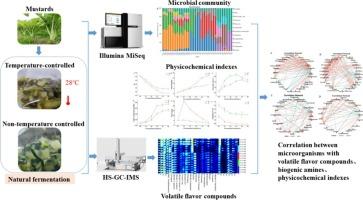Effect of temperature on the quality and microbial community during Daocai fermentation
IF 6.5
1区 农林科学
Q1 CHEMISTRY, APPLIED
引用次数: 0
Abstract
Daocai is a traditional salted pickle in the southeastern region of Guizhou with a unique aroma, color, and taste. The quality of Daocai is greatly influenced by the fermentation temperature. In this study, high-throughput sequencing and headspace-gas chromatography-ion mobility spectrometry were used to investigate the changes in microbial community succession and volatile flavor compounds during Daocai fermentation under temperature-controlled (D group) and non-temperature-controlled (C group).We found that the predominant genera in the C group samples were Latilactobacillus(40.57 %), Leuconostoc(21.25 %), Cystofilobasidium(22.12 %), Vishniacozyma(23.89 %), and Leucosporidium(24.95 %), whereas Weissella(29.39 %), Lactiplantibacillus(45.61 %), Mucor(68.26 %), and Saccharomyces(23.94 %) were the predominant genera in the D group. A total of 92 VFCs were detected in Daocai samples, including 5 isothiocyanates, 16 esters, 14 alcohols, 24 aldehydes, 17 ketones, 3 acids, 2 pyrazines, 1 pyridines, 1 thiazoles, 3 furans, 4 alkenes, and 2 nitriles. Further analysis revealed Latilactobacillus, Leuconostoc, Lactococcus, Cystofilobasidium, Leucosporidium, Holtermanniella, and Dioszegia as key bacteria involved in flavor formation. They are closely related to the formation of flavors such as aldehydes, furans, pyridines, and alkenes. This study contributes to our understanding of the relationship between bacterial communities and the flavor formation during Daocai fermentation.

温度对大白菜发酵过程中的质量和微生物群落的影响
道菜是贵州东南部地区的一种传统咸菜,具有独特的香气、色泽和口感。发酵温度对道菜品质的影响很大。本研究采用高通量测序和顶空气相色谱-离子迁移谱法研究了控温(D组)和非控温(C组)条件下道菜发酵过程中微生物群落演替和挥发性风味化合物的变化。我们发现,C 组样品中的优势菌属为拉氏乳杆菌(40.57 %)、白念珠菌(21.25 %)、子囊菌(22.12 %)、维氏乳杆菌(23.而 D 组的主要菌属为魏氏菌(29.39 %)、乳杆菌(45.61 %)、粘菌(68.26 %)和酵母菌(23.94 %)。在道才样本中总共检测到 92 种 VFCs,包括 5 种异硫氰酸盐、16 种酯、14 种醇、24 种醛、17 种酮、3 种酸、2 种吡嗪、1 种吡啶、1 种噻唑、3 种呋喃、4 种烯和 2 种腈纶。进一步分析发现,拉氏乳杆菌、白念珠菌、乳球菌、囊丝菌、白孢子菌、霍尔特曼菌和薯蓣皂苷菌是参与风味形成的主要细菌。它们与醛、呋喃、吡啶和烯类等风味的形成密切相关。这项研究有助于我们了解大白菜发酵过程中细菌群落与风味形成之间的关系。
本文章由计算机程序翻译,如有差异,请以英文原文为准。
求助全文
约1分钟内获得全文
求助全文
来源期刊

Food Chemistry: X
CHEMISTRY, APPLIED-
CiteScore
4.90
自引率
6.60%
发文量
315
审稿时长
55 days
期刊介绍:
Food Chemistry: X, one of three Open Access companion journals to Food Chemistry, follows the same aims, scope, and peer-review process. It focuses on papers advancing food and biochemistry or analytical methods, prioritizing research novelty. Manuscript evaluation considers novelty, scientific rigor, field advancement, and reader interest. Excluded are studies on food molecular sciences or disease cure/prevention. Topics include food component chemistry, bioactives, processing effects, additives, contaminants, and analytical methods. The journal welcome Analytical Papers addressing food microbiology, sensory aspects, and more, emphasizing new methods with robust validation and applicability to diverse foods or regions.
 求助内容:
求助内容: 应助结果提醒方式:
应助结果提醒方式:


